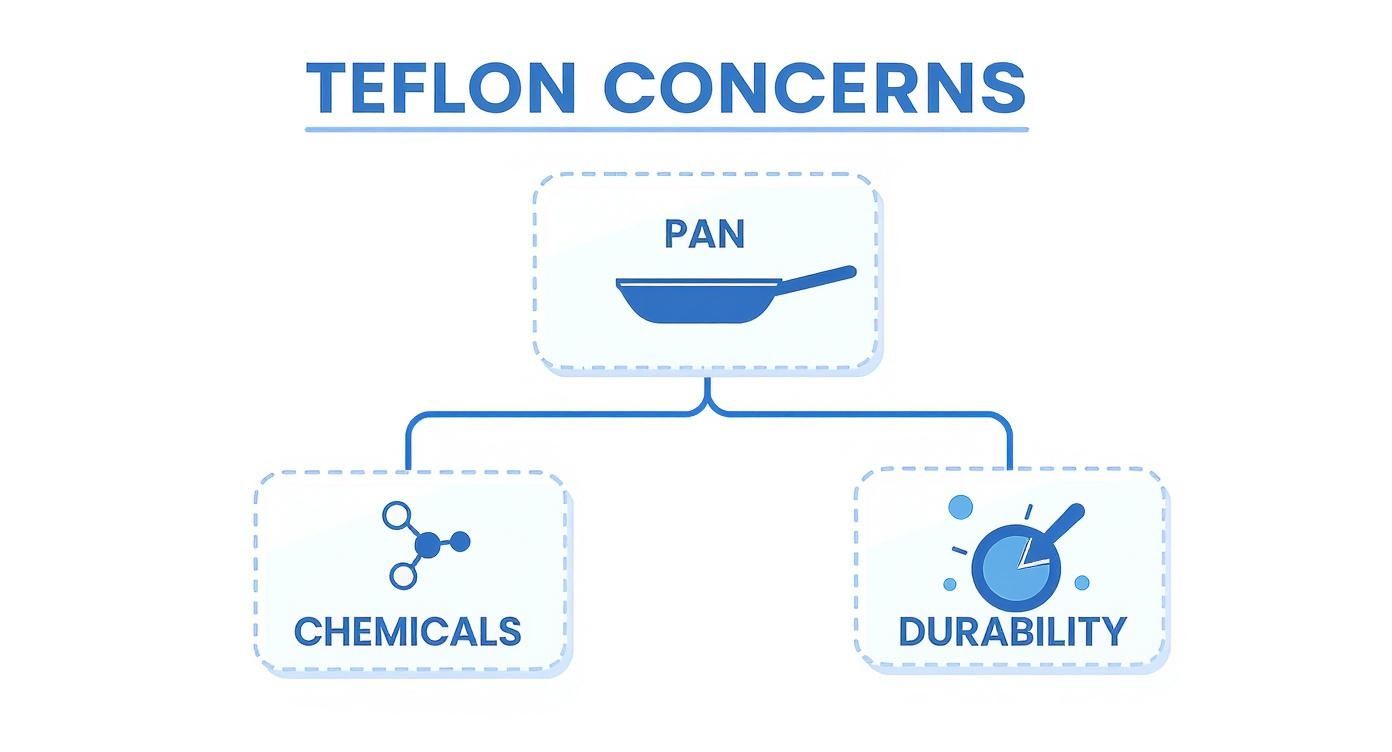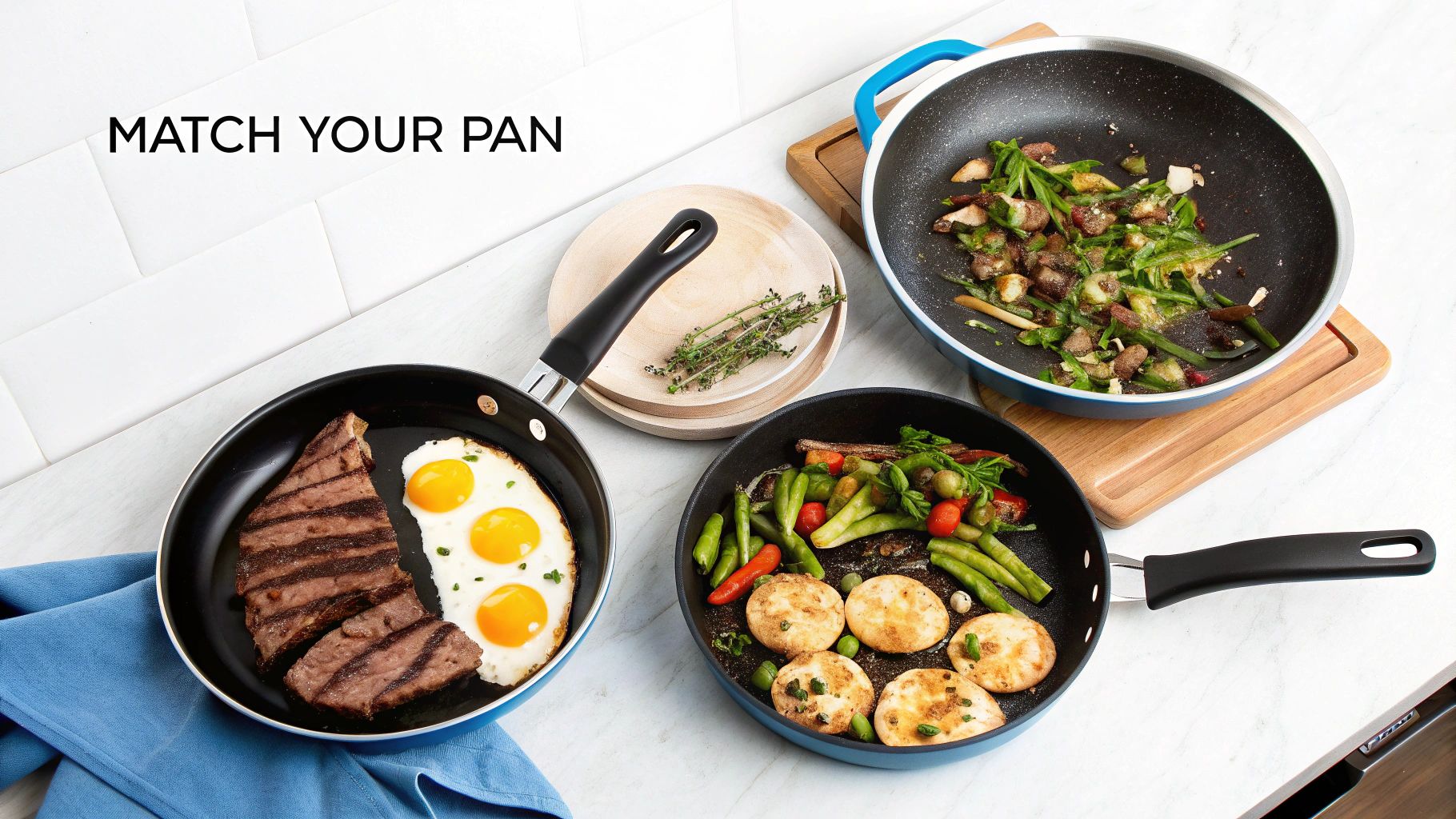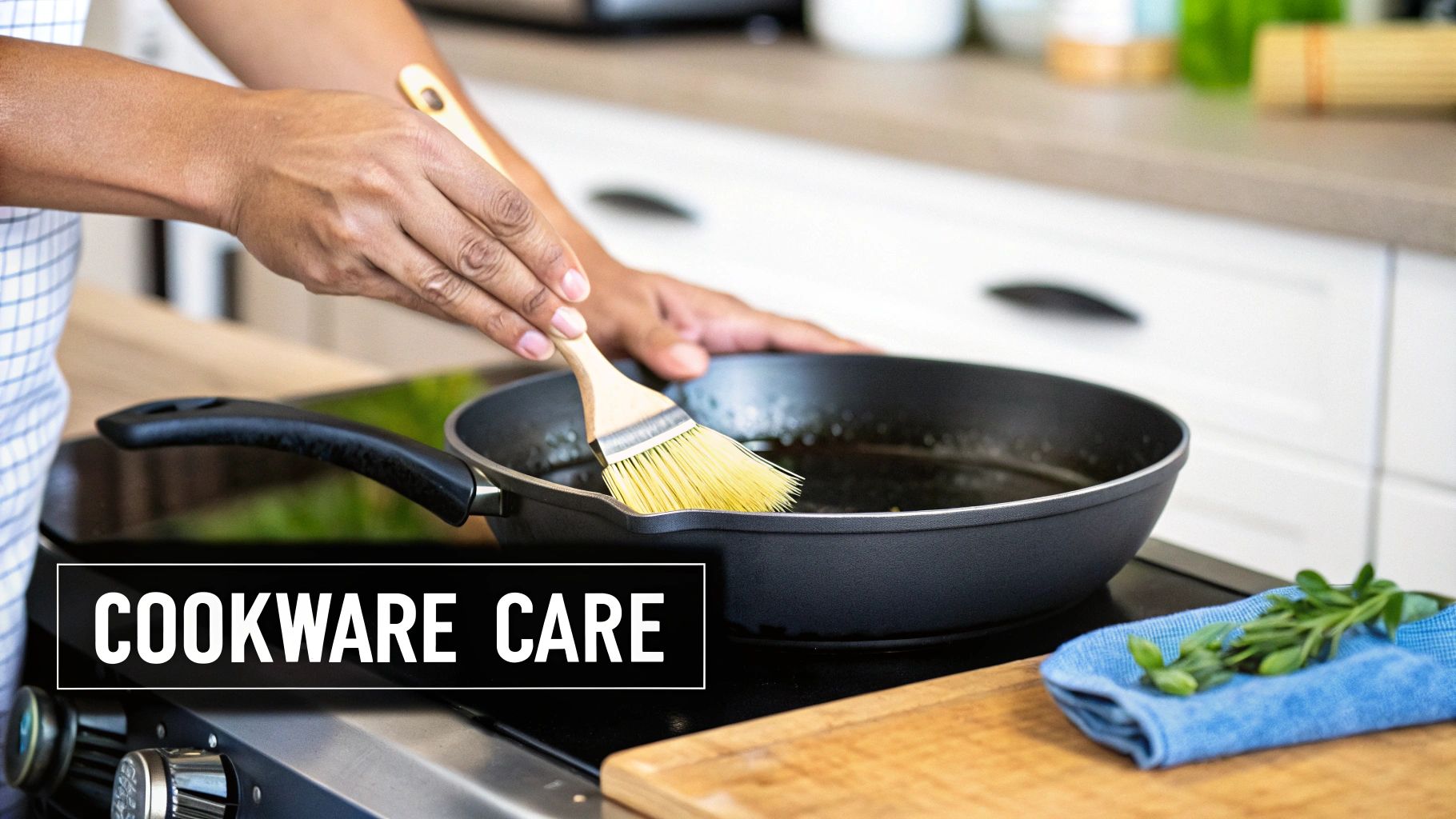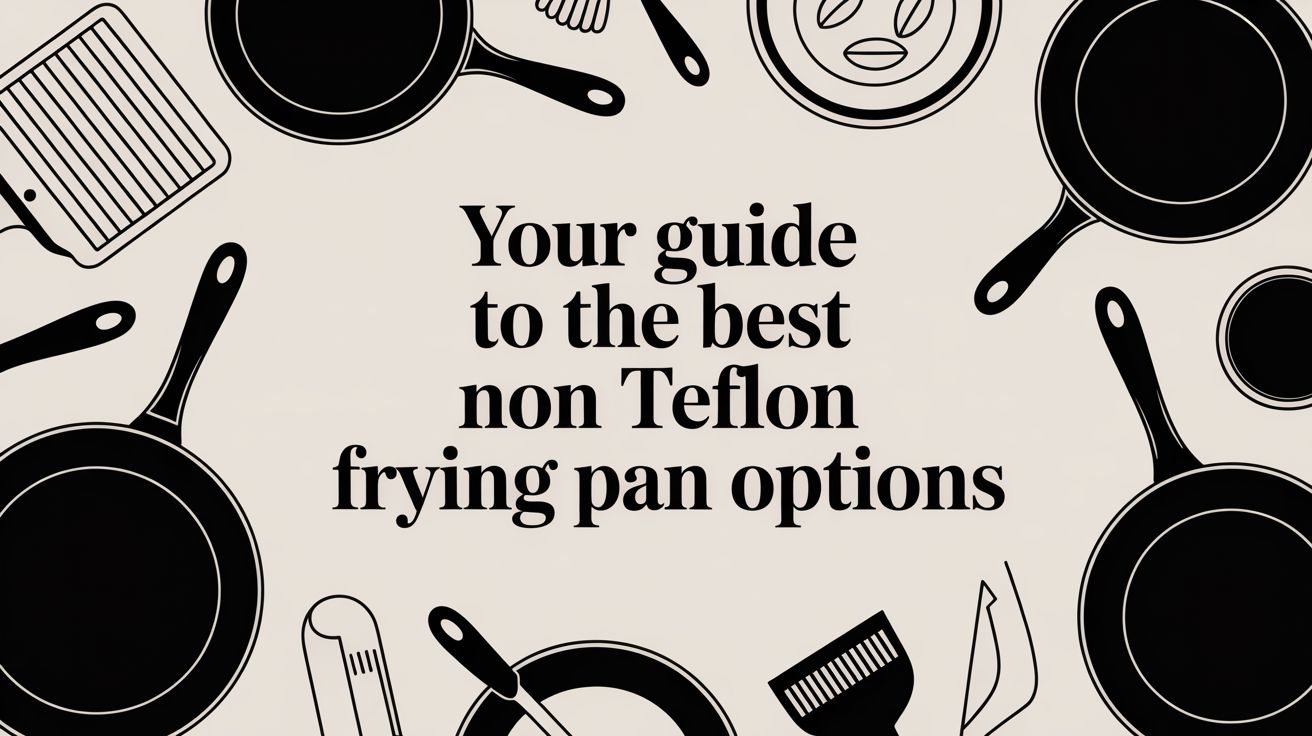A non-Teflon frying pan simply uses a different material for its cooking surface, like ceramic, cast iron, or stainless steel, instead of the traditional PTFE coatings. These alternatives are becoming the go-to choice for health-savvy home cooks who want durable, long-lasting cookware without the chemical worries that can come with overheating old-school non-stick pans.
Why Modern Kitchens Are Ditching Teflon Pans
For years, Teflon was king in the kitchen. The promise of a pan so slick that food just slid right off seemed like pure magic, and it quickly became a household staple. But times are changing. A growing wave of home cooks are now deliberately stepping away from these traditional non-stick pans, driving a real shift in the cookware world.
This isn't just some passing fad. It’s a move based on a better understanding of what our cookware is made of and how it performs over the long haul. The main issue centres on the chemical coating itself: Polytetrafluoroethylene (PTFE). When this coating gets too hot—typically above 260°C—it can start to break down and release fumes that have raised serious health questions. For many people, the convenience just doesn't balance out the potential risks anymore.
The Search for Safer Alternatives
It’s not just about health, either. Home cooks are also looking for pans that are built to last. We've all been there—that frustrating moment when a metal spatula leaves a scratch, or a bit of high heat ruins the non-stick layer forever. Coated pans often have a frustratingly short lifespan, and people are tired of replacing them every year or two. This has pushed many to find a non-Teflon frying pan that can handle the rigours of daily cooking and become a trusted kitchen companion for years.
This shift is clearly visible in market trends.
In Australia, while the non-stick cookware market generated USD 338.3 million in revenue in 2024, there's a definite consumer swing towards materials like ceramic and other non-Teflon options. According to Grand View Research, this is largely fuelled by concerns over the chemical breakdown of traditional coatings at high temperatures.
Ultimately, this movement is about more than just dodging certain chemicals. It’s about investing in kitchen tools that give you peace of mind and deliver fantastic cooking results. If creating a healthier kitchen is high on your list, you can learn more in our guide to the best cookware for health. The modern kitchen is becoming a place where safety, durability, and versatility are valued just as much as a quick clean-up.
Comparing the Top Non Teflon Frying Pan Materials
Choosing a non-Teflon frying pan can feel a bit like picking a partner for your kitchen adventures. Each material has its own personality—its strengths, its quirks, and the unique way it handles the heat. Let's break down the best options out there so you can find your perfect match.
Think of this as your personal cookware showroom. We'll explore Cast Iron, the rugged workhorse that only gets better with age, and sleek Stainless Steel, the professional's go-to for a perfect sear. We’ll also look at modern Ceramic and tough Hard-Anodised Aluminium to help you decide what’s right for your stove.
The visual below really gets to the heart of why so many home cooks are moving away from traditional coated pans, zeroing in on chemical composition and how durability breaks down over time.

It’s clear that this shift is driven by two things: a desire for chemical safety in the kitchen and the need for cookware that doesn't easily scratch, chip, or degrade with regular use.
Cast Iron: The Timeless Classic
A well-seasoned cast iron skillet is the stuff of culinary legend. It’s a heavy, incredibly durable piece of cookware that, with the right care, can be passed down for generations. Its true superpower is heat retention; once it gets hot, it stays hot, giving you an even and consistent cooking surface that’s hard to beat.
This makes it perfect for searing steaks, frying crispy chicken, or baking cornbread with that enviable golden-brown crust. And here’s the best part: the more you cook with it, the better it gets. Layers of cooked-on oil, known as seasoning, build up to create a natural, non-stick surface.
But, cast iron does demand a bit of a commitment. It needs regular seasoning to maintain its non-stick quality and prevent rust. You can’t just leave it to soak in the sink. It’s also quite heavy and can react with acidic foods like tomatoes if the seasoning isn't perfectly established.
Stainless Steel: The Professional’s Choice
Walk into almost any professional kitchen, and you’ll see walls of gleaming stainless steel pans. Chefs prize this material for its durability, non-reactive surface, and its knack for heating up quickly and evenly. It’s the ideal tool for browning meats, sautéing vegetables, and creating incredible pan sauces.
Unlike cast iron, stainless steel won't react with acidic ingredients, so your tomato sauce will taste exactly as it should. It can also handle seriously high temperatures and is generally dishwasher safe, which makes cleanup a breeze.
The catch? It doesn't have a built-in non-stick surface. Mastering heat control and using the right amount of oil is key to stopping food from sticking. It also has a lesser-known cousin worth a look; you can dive into the benefits in our article on titanium cookware in Australia.
Ceramic: The Smooth Operator
Ceramic-coated pans offer a non-toxic, non-stick surface that’s fantastic for cooking delicate foods like eggs and fish without needing much oil. The coating is derived from sand and is completely free from PTFE and PFOA, giving health-conscious cooks genuine peace of mind.
These pans are often colourful, lightweight, and incredibly easy to clean. They provide a genuinely slick surface straight out of the box, making them a very user-friendly option, especially for beginners.
A key thing to remember with ceramic is durability. The non-stick coating can wear down over time, particularly if it's overheated or you use abrasive scrubbers. It’s a great choice for low to medium-heat cooking but probably won’t last as long as a cast iron or stainless steel pan.
Hard-Anodised Aluminium: The All-Rounder
Hard-anodised aluminium has become a popular middle-ground option for good reason. The electrochemical process it goes through makes it significantly stronger and more durable than regular aluminium. This creates a surface that’s both scratch-resistant and non-reactive.
This material is also an excellent heat conductor. It heats up fast and distributes that heat evenly across the pan, which helps prevent annoying hot spots that burn your food. It’s a versatile workhorse, ready for almost any cooking task you throw at it.
While the global non-stick market hit USD 8.12 billion in 2024, Australian home cooks are increasingly favouring materials like hard-anodised aluminium. This is largely due to its blend of durability and corrosion resistance, all without the concerns of PTFE breaking down at temperatures over 300°C. You can explore more non-stick cookware market trends on GrandViewResearch.com.
How to Match a Pan to Your Cooking Style

Choosing the best non-teflon frying pan isn't about just grabbing one off the shelf. It’s about finding a cooking partner that slots perfectly into your kitchen routine. The right pan should feel like a natural extension of your own hands, helping you get the results you're after without a fight.
So, how do you cook? Are you a busy weeknight warrior who just needs to get dinner on the table fast with minimal fuss? Or are you a weekend gourmet who obsesses over getting that perfect, crusty sear on a steak? Your answer will point you toward completely different pans.
For the Fast and Efficient Cook
If your evenings feel like a race against the clock, you need cookware that’s on your team. You’re looking for something lightweight that heats up in a flash and doesn’t demand a half-hour of scrubbing after the meal is over.
This is where a ceramic pan really comes into its own. It's built for those quick, low-fuss meals like scrambled eggs or a delicate piece of fish, and its slick surface basically wipes clean. It lets you get on with your evening, no dreaded cleanup session required.
For the Sear and Sizzle Specialist
Do you live for that unmistakable sound of a steak hitting a screaming-hot pan? If your whole reason for cooking is to build deep, flavourful crusts, you need a pan that can get seriously hot and stay that way.
This is the domain of cast iron and stainless steel. Their incredible heat retention is the secret to that restaurant-quality sear. These pans are made for high-temperature cooking, allowing you to develop complex flavours that lighter pans just can't touch. Sure, they take a little more technique to master, but the payoff is huge.
The big surge in home cooking is what's really driving the cookware market these days. More and more Australians are getting adventurous in the kitchen, and that means they’re after specialised pans that can deliver professional-level results.
You can see this reflected in the numbers. The Australian cookware market, which includes all these fantastic non-Teflon options, was valued at around USD 664.44 million in 2024. Experts predict it could almost double by 2033, all thanks to our growing passion for cooking at home. You can dig into more of the data on the Australian cookware market growth at IMARC Group.
Key Features Beyond the Material
Once you've zeroed in on the right material for your style, it's time to think about the pan's design. These little details make a massive difference in how a pan feels and performs day in and day out.
- Handle Comfort: How does the handle feel in your hand? A secure, balanced grip makes cooking a pleasure, while a bad one turns it into a chore.
- Overall Weight: That heavy cast iron skillet is a beast for searing, but you probably don't want to be flipping pancakes with it. Pick a weight you can handle with confidence.
- Oven Safety: If you love those recipes that start on the stovetop and finish in the oven, check that the entire pan, handle and all, is oven-safe.
Thinking about these factors will help you choose a pan that not only cooks brilliantly but also feels like it was made just for you. For more tips, have a look at our guide on finding good quality pots and pans that will stand the test of time.
Caring for Your Cookware Like a Pro

A good non-Teflon frying pan isn't just a purchase; it's an investment in your kitchen. When you find the right one, it'll reward you with better-cooked meals and reliable performance for years to come. But here's the secret: getting the most out of it all comes down to how you care for it.
Each material has its own little quirks and needs. Don't worry, it's not complicated. Mastering a few simple maintenance habits will keep your cookware in prime condition, transforming a good pan into an indispensable kitchen partner. These aren't chores—they're just small rituals that protect your pan's surface and extend its life well beyond any standard coated pan.
The Ritual of Seasoning Cast Iron
The word "seasoning" sounds a bit mysterious, doesn't it? In reality, it’s just the simple process of baking oil onto the iron to create a natural, non-stick surface. Think of it as building up a protective shield for your pan, one that gets tougher and slicker every time you cook. A beautifully seasoned cast iron pan is the original non-Teflon frying pan, and it delivers incredible results without any synthetic coatings.
Here’s how to get it right:
- Clean and Dry: Give your new pan a good wash with warm, soapy water. Then, dry it. And I mean completely dry it—moisture is the arch-nemesis of cast iron.
- Apply Oil: Grab a neutral cooking oil like canola or vegetable oil and rub a very thin layer over the entire pan, inside and out.
- Bake It: Pop the pan upside down in your oven, preheated to about 230°C, and let it bake for an hour. Turn the oven off and let it cool down completely inside.
That’s it. This process polymerises the oil, bonding it to the metal to create that crucial first layer. The more you cook with it, the better that seasoning will get.
Mastering Stainless Steel and Ceramic Care
Stainless steel and ceramic pans don't need seasoning, but they do appreciate a different kind of attention. With stainless steel, the key to stopping food from sticking isn't a special coating, it's all about managing your heat properly. Always preheat your pan over medium heat for a minute or two before you add any oil. This simple step closes the microscopic pores in the metal, creating a naturally slicker surface.
For both stainless steel and ceramic, gentle care is the name of the game if you want them to last.
Pro Tip: Whatever you do, don't use metal utensils on your ceramic-coated pan. While the coating is great, it's more delicate than bare metal. Stick to silicone, nylon, or wooden utensils to avoid scratches that will ruin its non-stick magic.
To keep these pans working their best, just remember these simple rules:
- Hand Wash: I know some pans say "dishwasher safe," but the high heat and harsh detergents will wear down the surface over time. A quick, gentle hand wash is always the safer bet.
- Avoid Abrasives: Stay away from steel wool or anything super scratchy. If you have a stubborn, stuck-on mess, a simple paste of baking soda and water is a fantastic, non-abrasive solution.
- Let it Cool: Never, ever plunge a sizzling hot pan into cold water. The drastic temperature change—called thermal shock—can cause your pan to warp or even crack.
Busting Common Myths About Non-Teflon Pans
Stepping into the world of non-Teflon cookware can feel a bit intimidating, especially with all the myths and half-truths floating around. It’s easy to get bogged down by worries about food sticking, complicated cleaning, and maintenance that sounds like it needs its own instruction manual.
But here’s the thing: most of these fears are completely unfounded. They usually stem from old-school advice or just not knowing the little tricks that make these pans shine. Let’s tackle some of the biggest myths head-on, so you can cook with confidence.
Myth 1: Food Always Sticks to Stainless Steel
Ah, the classic. We’ve all seen the pictures—a sad, mangled egg stuck fast to a beautiful stainless steel pan. This is probably the number one reason people hesitate, but the pan isn't the problem. The real culprit is almost always heat management.
Unlike pans with a chemical coating, stainless steel needs a moment to get ready before you introduce any food. You have to preheat it first, before you even think about adding oil. This gives the metal a chance to expand and seal up its microscopic pores, creating a naturally slicker surface.
The secret? Patience. Heat your pan over a medium flame for a minute or two. Do the water-drop test: flick a bit of water in. If it sizzles and evaporates, it's not ready. If it beads up and dances around like a mercury ball, you've hit the sweet spot. Now, add your oil, let it shimmer, and you're good to go. It’s technique, not a coating, that makes stainless steel non-stick.
Myth 2: Cast Iron Is Too Much Work
The word "seasoning" can conjure images of some ancient, laborious ritual. While cast iron does ask for a different kind of care than your average pan, it’s nowhere near as demanding as people make it out to be. Think of seasoning less as a chore and more as building a relationship with your pan. You're simply baking on layers of oil to create a tough-as-nails, all-natural non-stick finish.
Once you’ve got a good base layer of seasoning, daily upkeep is a breeze. Seriously.
- Clean with hot water: After cooking, a quick rinse under hot water with a brush or scraper is usually all you need. Forget the soap—it can strip away your hard-earned seasoning.
- Dry it immediately: This is non-negotiable. Water is the enemy of iron. Towel it dry or pop it back on a low burner for a minute to ensure every last drop of moisture is gone.
- Give it a light oiling: While the pan is still warm, wipe a super-thin layer of cooking oil all over the inside with a paper towel.
The whole routine takes less than two minutes. It's a simple rhythm you get into, and it's what will keep your non-Teflon frying pan in the family for generations.
Your Questions About Non-Teflon Frying Pans Answered
https://www.youtube.com/embed/EpkVegTcwbo
So, you've brought home a new non-Teflon frying pan. It’s completely normal to have a few questions as you get the hang of it. This kind of cookware definitely behaves differently from the coated pans you might be used to, but mastering it is surprisingly simple once you understand the basics.
Let's walk through some of the most common questions people have, so you can feel totally confident every time you fire up the stove.
Are Ceramic Coatings Durable?
This is probably the number one question on everyone's mind. A quality ceramic pan can be a dream to cook with, but its lifespan really hinges on two things: the quality of the brand you buy and how you look after it. A well-made, robust ceramic coating will always outlast a cheap, thin one.
But proper care is just as crucial. The golden rule is to avoid extreme heat and anything that can scratch the surface.
- Stick to low to medium heat: Blasting it on high can cause the ceramic coating to wear down much faster.
- Use the right tools: Always reach for silicone, nylon, or wooden utensils to avoid scratching the finish.
- Hand wash with care: Harsh dishwasher detergents and abrasive scourers are the enemy of a ceramic surface. A gentle hand wash is best.
With a little TLC, a good ceramic pan will be a reliable friend in your kitchen for years to come.
Why Is Food Sticking to My Stainless Steel Pan?
If you're finding that food is sticking to your new stainless steel pan, I can almost guarantee the issue is heat control, not a problem with the pan itself. Unlike coated pans, stainless steel must be properly preheated before you even think about adding oil. Skipping this step is the main reason people struggle.
Here’s a way to think about it: heating the pan first causes the steel's pores to shrink and close up. This creates a much smoother, flatter surface for your food to glide across.
The secret is to heat the dry pan over a medium flame for a minute or two, then add your oil. Wait for the oil to shimmer slightly—that’s your signal that it’s ready. This one simple technique turns stainless steel from a sticky mess into a high-performance searing machine.
Is a Heavy Cast Iron Pan Really Worth It?
Without a doubt. Especially if you’re someone who loves creating deep, rich flavours in your cooking. The weight of a cast iron pan is actually its biggest asset. All that dense iron is incredible at holding onto heat, giving you the even, powerful temperature needed for a perfect crust on a steak or unbelievably crispy fried chicken.
It's an investment in a different style of cooking. Sure, it needs a bit of looking after with regular seasoning, but in return, you get an amazing cooking surface that only gets better with age. A well-cared-for cast iron pan will genuinely last a lifetime. For anyone passionate about food, the results are more than worth the extra muscle.
Discover the lasting performance of pure titanium cookware at Everti. Explore our collection of ultra-durable, non-toxic kitchen essentials designed for a lifetime of healthy cooking. Visit https://everti.com.au to learn more.

